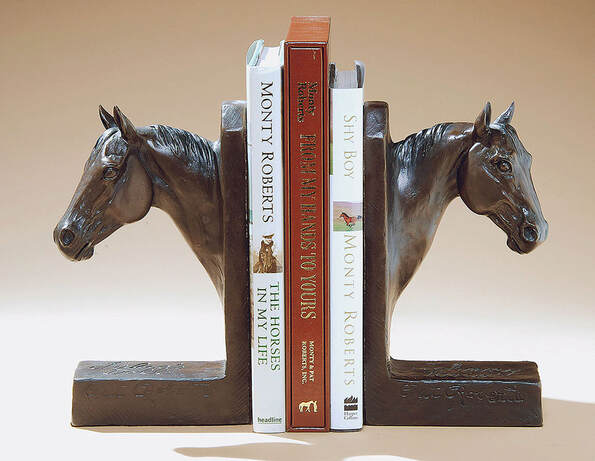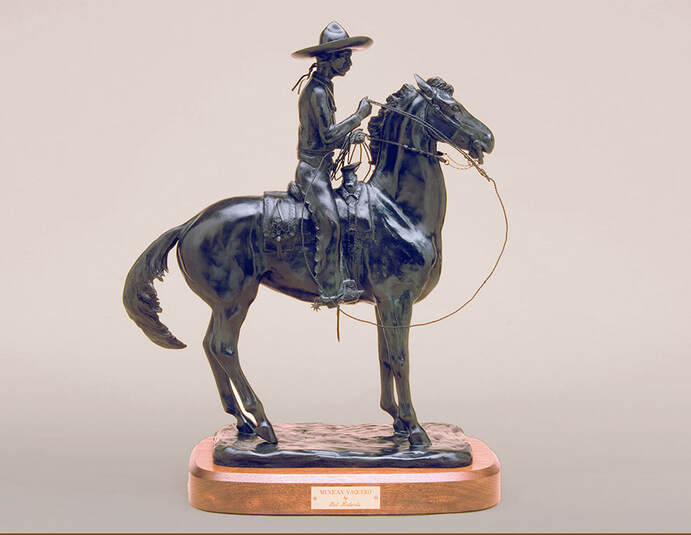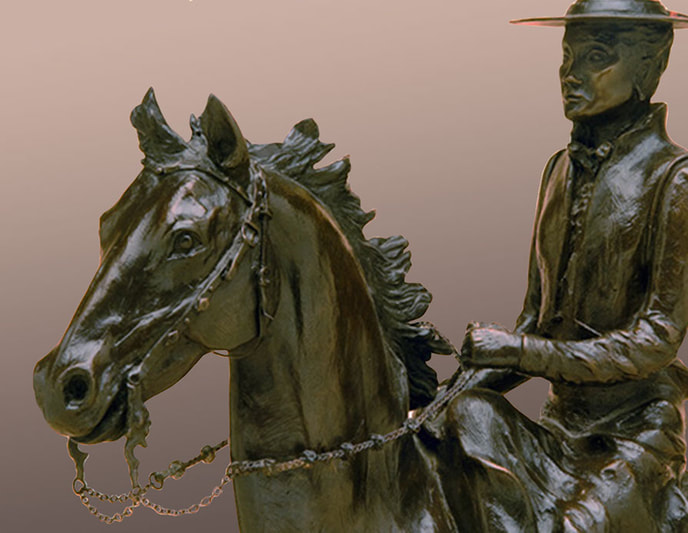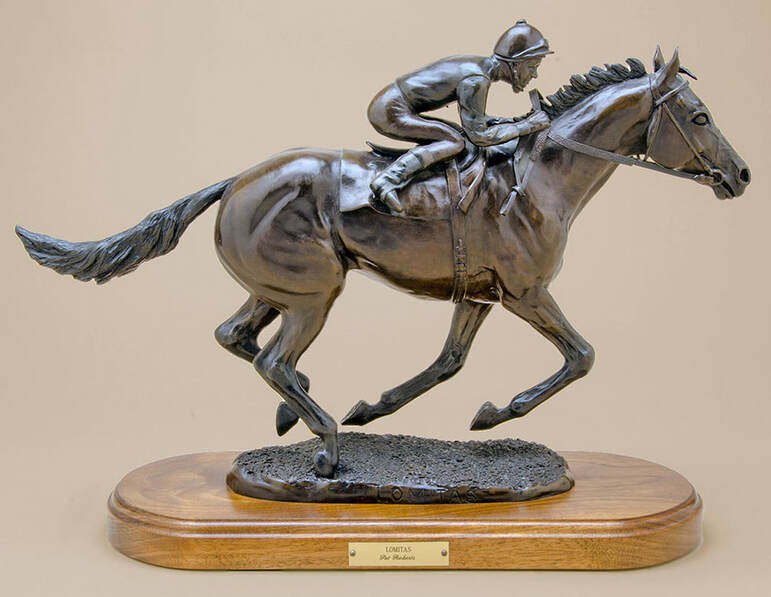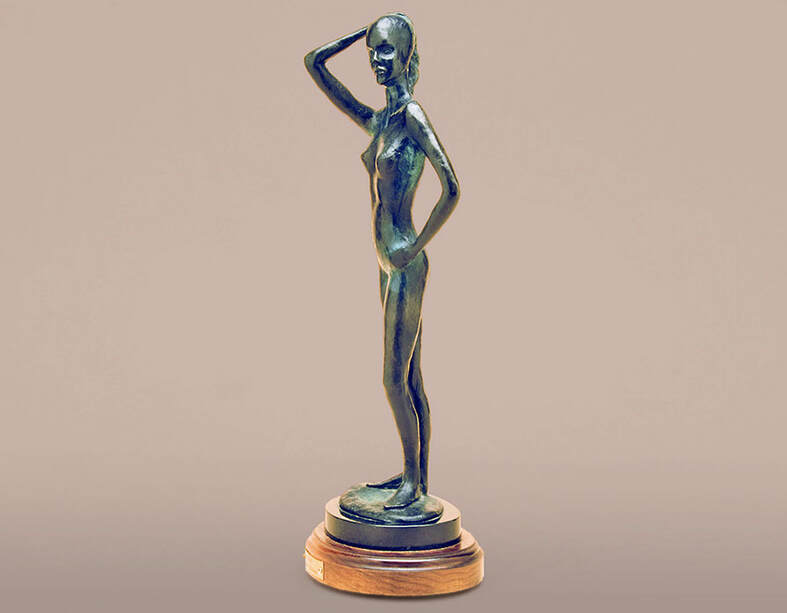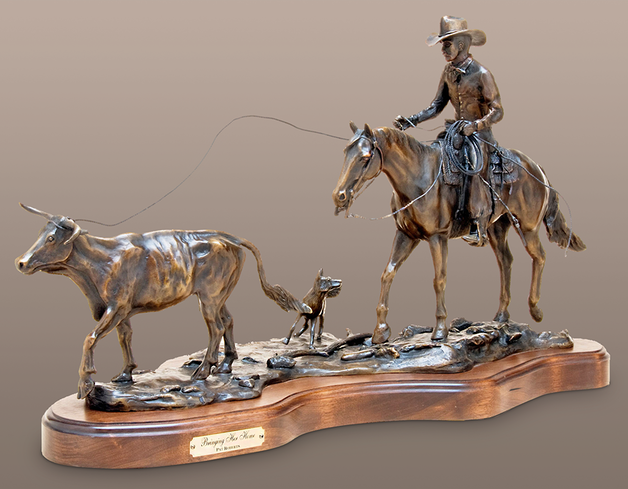Interview With
Pat Roberts
Sculpture
“Horses and sculpture are all about movement. As an artist, I strive to capture a moment in time… but even when I depict an animal standing still, it must still move in the eye of the viewer to be alive.” —Pat Roberts
https://www.patrobertssculpture.com/index.html
Cowboy'n Up
Limited edition of 20, 17 x 14 x 23 inches, bronze.
Limited edition of 20, 17 x 14 x 23 inches, bronze.
Johnny Tivio and Julia's Doll Bookends
Limited edition of 500, 5.25 x 2.5 x 9 inches each piece, bronze.
Limited edition of 500, 5.25 x 2.5 x 9 inches each piece, bronze.
Cowgirl Up—detail
Pat’s favorite subjects are naturally—horses, as well as other animals.
Her bronzes are found in collections across fourteen countries and in the homes of royalty, museums and corporate presidents.
Her bronzes are found in collections across fourteen countries and in the homes of royalty, museums and corporate presidents.
Lily
Limited edition of 20, 21 inches tall, bronze on marble.
Limited edition of 20, 21 inches tall, bronze on marble.
Hello Pat,
It is such a pleasure to have the opportunity to speak with you in this digital space.
Your Sculpture is amazing. My first question is where are you from Pat?
Pat Roberts; My earliest recollection of my lifetime love affair with horses began when I was a little over two years old. My parents lived in the town but the majority of my relatives lived in the country on ranches and farms. As I grew up, my favorite time of the year was summer when I could live with the families and work with the horses.
When I married Monty Roberts, a professional horseman in 1956, my life was totally immersed in living with and showing horses. This pursuit, along with my art, has continued to be the focus of my life, I presently show a wonderful gelding I bred, Black Design. He is the great grandson of a mare I showed during the 1960’s in a different event which involved pleasure and halter.
“Blackie” and I compete in the working cow horse events which involves reining and boxing cows.
As a team, Blackie and I have won numerous buckles and a trophy saddle here in California and in Nevada.
TNYO: Can you tell us what it is like to be an Equestrian and did you grow up with Horses and do you still ride ?
Pat Roberts: I have always been interesting in breeding and have been responsible for producing four generations of champion Quarter Horses, the last of which is my Blackie. In addition to breeding, training and showing Quarter Horses, my husband and I were the leading consignors of Two-Year-Old Thoroughbred horses in training sales for 18 years. This involved going to Kentucky and New York to Thoroughbred yearling sales, choosing the right individual, training them from fall to spring and then taking them to the sales to sell.
It was paramount that one chooses individuals that are correct in conformation as well as having the best bloodlines. For me, this was a university of learning and my husband brags about my having a ‘good eye’ for conformation. I feel this is what has helped me sculpt horses that are correct and I am recognized for my ability to depict this in my equine sculptures.
TNYO: Training Breeding and showing award winning horses is fascinating. Can you tell us more about this
process and how it translates into your art?
Pat Roberts: My goal has always been to capture that moment in time bringing to life movement to the eye of the beholder. As one can imagine, this is not the easiest to achieve with cold, hard bronze. Using my experience of looking at horses at the sales has taught me the importance of an armature that is correct in the dimensions to begin with. Just as one is aware of the skeleton of the horse, the pipe and wire armatures must be correct. I next start to add the clay and begin to sculpt the muscling and the nuances that creates a believable animal. I feel the years of looking at horses has given me an edge in being successful with creating animals, but horses in particular, that happen to be my favorite subject. I do love the challenge of sculpting other animals and have done cheetahs, long horn steers, cows, deer, dogs and wild pigs to name a few.
Once I have a completed clay sculpture, I then deliver it to my foundry. There they will build what I call a ‘mother mold’ from latex rubber and plaster from my original model. The clay is removed from the mold that consists of two halves. The next step is to place the halves back together and pour a wax model. If there are any changes needed at that point, it can be done in the wax. My sculptures are usually limited, numbered editions with the exception of a few commissions. I pride myself on watching each step of the creation of the bronze process rather than rely on the foundry to make any changes without my eyes. This ‘lost wax’ process has been in existence since before the Ming dynasty.
TNYO: What materials and processes do you use when creating your sculptures?
Pat Roberts: Once I have a completed clay sculpture, I then deliver it to my foundry. There they will build what I call a ‘mother mold’ from latex rubber and plaster from my original model. The clay is removed from the mold that consists of two halves. The next step is to place the halves back together and pour a wax model. If there are any changes needed at that point, it can be done in the wax. My sculptures are usually limited, numbered editions with the exception of a few commissions. I pride myself on watching each step of the creation of the bronze process rather than rely on the foundry to make any changes without my eyes. This ‘lost wax’ process has been in existence since before the Ming dynasty.
TNYO: You mention on your website that you have no academic training outside of working with contemporary artists, Can you tell us about these artists and what that experience was like and how it helped build your craft?
Pat Roberts: After starting out painting when we moved first into the home where we now live, my husband asked me to create bronzes as he is color blind and couldn’t really appreciate my paintings. I took a six-week course at Santa Barbara City College and produced my first sculpture, a study of a nude. Wanting to create a horse after that, I struggled with the armature and since we were given hibachi sticks (instead of wire and pipe), I found it was impossible. Luckily a family friend visited and shared with me how to make the armature.
This was Jack Swanson, a wonderful CAA artist whose paintings were hung in Ronald Reagan's governor's office in California and then the White House during his presidency. Later I was lucky to study with Jack, Mehl Lawson, Grant Speed, Herb Mignery and other successful artists who were responsible for my continuing study of sculpture.
TNYO: Do you also collect other artists' work and if so what artwork do you love the most?
Pat Roberts: Collecting art began at a very early stage in my married life. My husband and I admired depictions of the West by Edward Borein; we started collecting in the 1950’s and own some fantastic original pen and inks plus quite a few wonderful etchings. One might say we have an extensive collection of art and might find it rather eclectic: Tom Darro, Dan McCaw, Glenn Dean, Jack Swanson, Feranc Daday, Elizabeth Lcchrie, Marjorie Jane Reed, Mark Geller, Harrison Begay, Frederick Zimmerman, E. John Robinson. George Strickland, Chuck Mardocz are a few of artists we have hanging in our home after collecting for more than sixty years.
TNYO: The details in your work are perfect. Can you tell us a little bit about your approach to the anatomy of your subjects?
Pat Roberts: With almost every sculpture I create, other than equine, I study my subject by using reference books and sometimes the Internet to gain the most knowledge of the anatomy of my chosen subject. I have an extensive library of reference books I have been collecting for over 50 years. There are some wonderful books such as Animal. Painting and Anatomy by W. Frank Calderon in which he illustrates the skeleton in great detail as well as the musculature. I refer to these whenever I start a study of an animal I haven’t previously sculptured. This is just one reference book I use, but I often refer to my mentors as to proportions, which make my sculptures flow because they are balanced and believable. Everyone I have studied with seems to have their own formula for obtaining the proportions that work.
TNYO: You are an award winning artist and that is well deserved, please tell us about the awards you have won?
Pat Roberts: I have been blessed to have been awarded many Best Sculpture awards over the years at Western art shows held mostly in California exhibits. One sculpture titled Equus in Flight has been Best Sculpture three times and was juried into the Gold Medal CAC exhibit at the Bowers Museum in 2022. My Don’t Mess with Mama was Best Sculpture, as well as Reserve Sculpture another time. I have entered and placed in Global competitions and had representation in London, Germany and Brussels. Two of my sculptures are in the Queen Elizabeth II collection at Windsor Castle. I have collectors in over ten different countries and corporate offices. Equus in Flight was purchased and donated to the Kentucky Horse Park in Lexington, Kentucky by a collector.
TNYO: Where do you see your art headed in the next 5 years Pat?
Pat Roberts: I plan on doing more animal sculptures in the future as there are a lot of animals I look forward to creating in bronze. I find when I decide on a certain specie it is important to have a name for the sculpture that resonates with the viewer. I believe that a ‘catchy’ name can help sell a sculpture. I’ve done a couple of nudes and found it was fun to work with human anatomy for a change, however I am better known as an equine/animal artist.
TNYO: I wonder do you listen to music when you work and if so what are some of your favorites songs?
Pat Roberts: Although I have an office/studio set aside for painting and sculpting, I usually end up in the large kitchen area of our home. The lighting is good, the space is ample and I have a Bose close by to listen to music while working. I’m totally a country music fan first and foremost. I prefer some of the older country singers over the new crop of singers popular today. A few of my favorites are Patsy Cline, Jim Reeves, Reba McIntire, Tim McGraw, Faith Hill, Ray Price ad George Straight. I have a huge collection of Allison Krauss, another of my favorites. Whether I am sculpting or just driving down the road, music will be with me.
It is such a pleasure to have the opportunity to speak with you in this digital space.
Your Sculpture is amazing. My first question is where are you from Pat?
Pat Roberts; My earliest recollection of my lifetime love affair with horses began when I was a little over two years old. My parents lived in the town but the majority of my relatives lived in the country on ranches and farms. As I grew up, my favorite time of the year was summer when I could live with the families and work with the horses.
When I married Monty Roberts, a professional horseman in 1956, my life was totally immersed in living with and showing horses. This pursuit, along with my art, has continued to be the focus of my life, I presently show a wonderful gelding I bred, Black Design. He is the great grandson of a mare I showed during the 1960’s in a different event which involved pleasure and halter.
“Blackie” and I compete in the working cow horse events which involves reining and boxing cows.
As a team, Blackie and I have won numerous buckles and a trophy saddle here in California and in Nevada.
TNYO: Can you tell us what it is like to be an Equestrian and did you grow up with Horses and do you still ride ?
Pat Roberts: I have always been interesting in breeding and have been responsible for producing four generations of champion Quarter Horses, the last of which is my Blackie. In addition to breeding, training and showing Quarter Horses, my husband and I were the leading consignors of Two-Year-Old Thoroughbred horses in training sales for 18 years. This involved going to Kentucky and New York to Thoroughbred yearling sales, choosing the right individual, training them from fall to spring and then taking them to the sales to sell.
It was paramount that one chooses individuals that are correct in conformation as well as having the best bloodlines. For me, this was a university of learning and my husband brags about my having a ‘good eye’ for conformation. I feel this is what has helped me sculpt horses that are correct and I am recognized for my ability to depict this in my equine sculptures.
TNYO: Training Breeding and showing award winning horses is fascinating. Can you tell us more about this
process and how it translates into your art?
Pat Roberts: My goal has always been to capture that moment in time bringing to life movement to the eye of the beholder. As one can imagine, this is not the easiest to achieve with cold, hard bronze. Using my experience of looking at horses at the sales has taught me the importance of an armature that is correct in the dimensions to begin with. Just as one is aware of the skeleton of the horse, the pipe and wire armatures must be correct. I next start to add the clay and begin to sculpt the muscling and the nuances that creates a believable animal. I feel the years of looking at horses has given me an edge in being successful with creating animals, but horses in particular, that happen to be my favorite subject. I do love the challenge of sculpting other animals and have done cheetahs, long horn steers, cows, deer, dogs and wild pigs to name a few.
Once I have a completed clay sculpture, I then deliver it to my foundry. There they will build what I call a ‘mother mold’ from latex rubber and plaster from my original model. The clay is removed from the mold that consists of two halves. The next step is to place the halves back together and pour a wax model. If there are any changes needed at that point, it can be done in the wax. My sculptures are usually limited, numbered editions with the exception of a few commissions. I pride myself on watching each step of the creation of the bronze process rather than rely on the foundry to make any changes without my eyes. This ‘lost wax’ process has been in existence since before the Ming dynasty.
TNYO: What materials and processes do you use when creating your sculptures?
Pat Roberts: Once I have a completed clay sculpture, I then deliver it to my foundry. There they will build what I call a ‘mother mold’ from latex rubber and plaster from my original model. The clay is removed from the mold that consists of two halves. The next step is to place the halves back together and pour a wax model. If there are any changes needed at that point, it can be done in the wax. My sculptures are usually limited, numbered editions with the exception of a few commissions. I pride myself on watching each step of the creation of the bronze process rather than rely on the foundry to make any changes without my eyes. This ‘lost wax’ process has been in existence since before the Ming dynasty.
TNYO: You mention on your website that you have no academic training outside of working with contemporary artists, Can you tell us about these artists and what that experience was like and how it helped build your craft?
Pat Roberts: After starting out painting when we moved first into the home where we now live, my husband asked me to create bronzes as he is color blind and couldn’t really appreciate my paintings. I took a six-week course at Santa Barbara City College and produced my first sculpture, a study of a nude. Wanting to create a horse after that, I struggled with the armature and since we were given hibachi sticks (instead of wire and pipe), I found it was impossible. Luckily a family friend visited and shared with me how to make the armature.
This was Jack Swanson, a wonderful CAA artist whose paintings were hung in Ronald Reagan's governor's office in California and then the White House during his presidency. Later I was lucky to study with Jack, Mehl Lawson, Grant Speed, Herb Mignery and other successful artists who were responsible for my continuing study of sculpture.
TNYO: Do you also collect other artists' work and if so what artwork do you love the most?
Pat Roberts: Collecting art began at a very early stage in my married life. My husband and I admired depictions of the West by Edward Borein; we started collecting in the 1950’s and own some fantastic original pen and inks plus quite a few wonderful etchings. One might say we have an extensive collection of art and might find it rather eclectic: Tom Darro, Dan McCaw, Glenn Dean, Jack Swanson, Feranc Daday, Elizabeth Lcchrie, Marjorie Jane Reed, Mark Geller, Harrison Begay, Frederick Zimmerman, E. John Robinson. George Strickland, Chuck Mardocz are a few of artists we have hanging in our home after collecting for more than sixty years.
TNYO: The details in your work are perfect. Can you tell us a little bit about your approach to the anatomy of your subjects?
Pat Roberts: With almost every sculpture I create, other than equine, I study my subject by using reference books and sometimes the Internet to gain the most knowledge of the anatomy of my chosen subject. I have an extensive library of reference books I have been collecting for over 50 years. There are some wonderful books such as Animal. Painting and Anatomy by W. Frank Calderon in which he illustrates the skeleton in great detail as well as the musculature. I refer to these whenever I start a study of an animal I haven’t previously sculptured. This is just one reference book I use, but I often refer to my mentors as to proportions, which make my sculptures flow because they are balanced and believable. Everyone I have studied with seems to have their own formula for obtaining the proportions that work.
TNYO: You are an award winning artist and that is well deserved, please tell us about the awards you have won?
Pat Roberts: I have been blessed to have been awarded many Best Sculpture awards over the years at Western art shows held mostly in California exhibits. One sculpture titled Equus in Flight has been Best Sculpture three times and was juried into the Gold Medal CAC exhibit at the Bowers Museum in 2022. My Don’t Mess with Mama was Best Sculpture, as well as Reserve Sculpture another time. I have entered and placed in Global competitions and had representation in London, Germany and Brussels. Two of my sculptures are in the Queen Elizabeth II collection at Windsor Castle. I have collectors in over ten different countries and corporate offices. Equus in Flight was purchased and donated to the Kentucky Horse Park in Lexington, Kentucky by a collector.
TNYO: Where do you see your art headed in the next 5 years Pat?
Pat Roberts: I plan on doing more animal sculptures in the future as there are a lot of animals I look forward to creating in bronze. I find when I decide on a certain specie it is important to have a name for the sculpture that resonates with the viewer. I believe that a ‘catchy’ name can help sell a sculpture. I’ve done a couple of nudes and found it was fun to work with human anatomy for a change, however I am better known as an equine/animal artist.
TNYO: I wonder do you listen to music when you work and if so what are some of your favorites songs?
Pat Roberts: Although I have an office/studio set aside for painting and sculpting, I usually end up in the large kitchen area of our home. The lighting is good, the space is ample and I have a Bose close by to listen to music while working. I’m totally a country music fan first and foremost. I prefer some of the older country singers over the new crop of singers popular today. A few of my favorites are Patsy Cline, Jim Reeves, Reba McIntire, Tim McGraw, Faith Hill, Ray Price ad George Straight. I have a huge collection of Allison Krauss, another of my favorites. Whether I am sculpting or just driving down the road, music will be with me.
Lad
Limited edition of 35, 20 x 10.5 x 12.75, bronze.
Limited edition of 35, 20 x 10.5 x 12.75, bronze.
Mexican Vaquero
Limited edition of 30, 19 x 20 x 7 inches, bronze.
Limited edition of 30, 19 x 20 x 7 inches, bronze.
Miss Tessie
Limited edition of 35, 18.5 x 22 x 6 inches, $4,501
Limited edition of 35, 18.5 x 22 x 6 inches, $4,501
Pat’s favorite subjects are naturally—horses, as well as other animals. Her bronzes are found in collections across fourteen countries and in the homes of royalty, museums and corporate presidents.
The years of experience as an accomplished horsewoman through training, breeding and showing championship horses has given Pat Roberts the opportunity to study the subject she loves best. It was a natural for her to gravitate toward creating numerous sculptures of the horse in motion.Pat, who says that she had had no formal training, has attended workshops given by contemporary artists she admires and credits for keeping her true to her own style, which has been described as realistic with just a touch of impressionism.
Pat likes to spend time capturing and creating the ambiance of both the Old and the
New West in her sculptures of charros, buckaroos, modern-day cowboys and old-time Western ladies who rode sidesaddle.
The years of experience as an accomplished horsewoman through training, breeding and showing championship horses has given Pat Roberts the opportunity to study the subject she loves best. It was a natural for her to gravitate toward creating numerous sculptures of the horse in motion.Pat, who says that she had had no formal training, has attended workshops given by contemporary artists she admires and credits for keeping her true to her own style, which has been described as realistic with just a touch of impressionism.
Pat likes to spend time capturing and creating the ambiance of both the Old and the
New West in her sculptures of charros, buckaroos, modern-day cowboys and old-time Western ladies who rode sidesaddle.
Moment of Join Up
Limited edition of 100, bronze—sold out
Limited edition of 100, bronze—sold out
Moving On
Limited edition of 35, 12 x 18 x 6 inches.
Limited edition of 35, 12 x 18 x 6 inches.
Lomitas
Limited edition of 30, 19 x 13 x 14.5 inches, bronze.
Limited edition of 30, 19 x 13 x 14.5 inches, bronze.
Look of Pride
Limited edition, bronze.
Limited edition, bronze.
Nude
Limited edition of 20, 17 inches on base, bronze.
Limited edition of 20, 17 inches on base, bronze.
What's Up Doc?
Limited edition of 100, 10.5 x 11.75 x 11.75 inches.
Limited edition of 100, 10.5 x 11.75 x 11.75 inches.
Badonkadonk
Good Morning
Bronze.
Bronze.
Bringing Her Home
Limited edition of 30, 29 x 15 x 11 inches, bronze.
Limited edition of 30, 29 x 15 x 11 inches, bronze.


